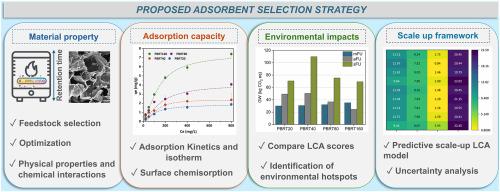通过绿色设计选择可持续吸附剂:将水处理性能、环境影响和规模化方案联系起来
IF 5.8
2区 化学
Q2 CHEMISTRY, MULTIDISCIPLINARY
引用次数: 0
摘要
活性炭(AC)是一种高度通用的吸附剂,由于其强大的吸附性能,用于水和废水处理应用。然而,广泛使用的传统煤制ACs造成了严重的环境问题,需要寻找可持续的替代品。本研究对热解保留时间优化后的松皮渣衍生吸附剂(PBA)的吸附能力和环境可持续性进行了评价。PBA具有较大的比表面积(506.88 m2/g)、发育良好的微孔和中孔,表面具有芳香C=O和C=H功能化,能快速去除腐植酸(qmax为- 9.81 mg/g)。采用基于质量的功能单元和基于新型应用的功能单元进行了从摇篮到闸门的生命周期评估(LCA),以充分探索合成的PBAs的可持续性。除了传统的中点影响类别(TRACI)外,本研究还量化了与PBA生产相关的累积能源需求、端点影响(人类健康、生态系统退化和资源枯竭)。该研究还严格量化了与传统吸附剂相关的环境影响,并对PBA进行了基准测试。此外,全面的扩大规模框架为确定试点和工业规模的交流生产的全部潜力提供了宝贵的见解。在这方面,实验分析和LCA建模的同步研究为吸附剂的可持续发展建立了一个结构化的、可测量的框架。本文章由计算机程序翻译,如有差异,请以英文原文为准。

Sustainable adsorbent selection through green design: Linking water treatment performance, environmental impacts and scale-up scenarios
Activated carbon (AC) is a highly versatile adsorbent utilized for water and wastewater treatment applications due to its strong adsorptive properties. However, the widely used conventional coal–derived ACs pose significant environmental concerns, necessitating the search for sustainable alternatives. The present study evaluates pyrolysis retention time optimized pine bark residue–derived adsorbent (PBA), for its adsorption capacity and environmental sustainability. The PBA featured a large specific surface area (506.88 m2/g), well–developed micro and mesopores, and surfaces functionalized with aromatic C=O and C=H, leading to the rapid removal of humic acid (qmax −9.81 mg/g). Cradle–to–gate life cycle assessment (LCA) was conducted with mass–based and the novel application–based functional units to fully explore the sustainability of the synthesized PBAs. In addition to conventional midpoint impact categories (TRACI), this study quantified the cumulative energy demand, endpoint impacts (human health, ecosystem degradation, and resource depletion), associated with PBA production. The study also critically quantifies the environmental impacts associated with the conventional adsorbents and benchmark PBA against its counterparts. Furthermore, the comprehensive scale–up framework provides valuable insights into identifying the full potential of AC production at pilot and industrial scales. In this aspect, the synchronous study involving both experimental analysis and LCA modeling establishes a structured and measurable framework for sustainable adsorbent development.
求助全文
通过发布文献求助,成功后即可免费获取论文全文。
去求助
来源期刊

Sustainable Chemistry and Pharmacy
Environmental Science-Pollution
CiteScore
8.20
自引率
6.70%
发文量
274
审稿时长
37 days
期刊介绍:
Sustainable Chemistry and Pharmacy publishes research that is related to chemistry, pharmacy and sustainability science in a forward oriented manner. It provides a unique forum for the publication of innovative research on the intersection and overlap of chemistry and pharmacy on the one hand and sustainability on the other hand. This includes contributions related to increasing sustainability of chemistry and pharmaceutical science and industries itself as well as their products in relation to the contribution of these to sustainability itself. As an interdisciplinary and transdisciplinary journal it addresses all sustainability related issues along the life cycle of chemical and pharmaceutical products form resource related topics until the end of life of products. This includes not only natural science based approaches and issues but also from humanities, social science and economics as far as they are dealing with sustainability related to chemistry and pharmacy. Sustainable Chemistry and Pharmacy aims at bridging between disciplines as well as developing and developed countries.
 求助内容:
求助内容: 应助结果提醒方式:
应助结果提醒方式:


